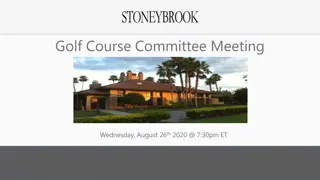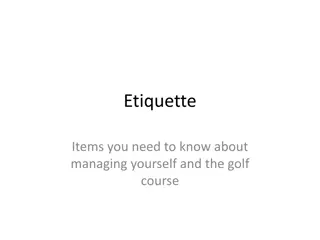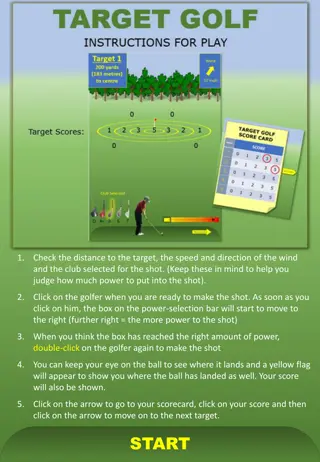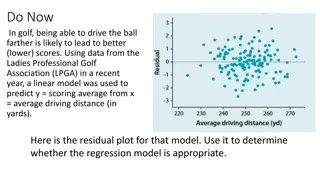Golf Industry Insights and Trends
The golf industry is seeing a slow but steady advancement, with an increase in rounds played in 2019 and a positive outlook for the future. Despite challenges such as equipment sales stagnation and online buying trends, there is optimism and potential for growth. Explore key findings and statistics shaping the golf ecosystem.
Download Presentation

Please find below an Image/Link to download the presentation.
The content on the website is provided AS IS for your information and personal use only. It may not be sold, licensed, or shared on other websites without obtaining consent from the author.If you encounter any issues during the download, it is possible that the publisher has removed the file from their server.
You are allowed to download the files provided on this website for personal or commercial use, subject to the condition that they are used lawfully. All files are the property of their respective owners.
The content on the website is provided AS IS for your information and personal use only. It may not be sold, licensed, or shared on other websites without obtaining consent from the author.
E N D
Presentation Transcript
The Game Slowly Advances The good news for the golf industry, according to the National Golf Foundation (NFG), is total rounds played during 2019 increased 1.5% from 2018 to a total of approximately 440 million, and despite many of the wettest months on record throughout the US. Sports & Leisure Research Group s 2020 report, Golf s Ecosystem, revealed 30% of golfers surveyed said they would play more golf during 2020, compared to 24% when asked for the 2019 survey. 52% were strongly optimistic about golf s future, a 16% YOY increase. The industry, however, is still somewhere on the back 9 far from the clubhouse, in terms of the millions of golfers who left the game during the past decade plus and still haven t returned in large numbers.
Next on the Tee According to The Media Audit s September 2019 Aggregate Survey (57 US markets, more than 157 million adults 18+), 5.0% of those adults played golf three or more times during the past 12 months and, unsurprisingly, 76.9% were men and 23.1% women. Adults 50+ continued to represent the bulk of golfers, or 48.7%, and 38.5% of them 55 and older. Nonetheless, 40.2% of all golfers were the younger adults (25 49) the game must attract to grow, and 31.2% were 25 34. Household income is still an accurate data point to identify golfers, as The Media Audit survey found 57.1% had incomes of $75K or more and 38.7% $100K+. Middle- income households ($35K $75K) were still well represented at 28.6%.
Golf on TV Still Attracts Eyeballs Even Without Tiger The Media Audit s survey also indicated that 7.6% of adults 18+ considered themselves golf fans, which is an interesting comparison to the 5.0% who played 3+ times during the past 12 months. Most were men (70.3%). A much larger percentage of adults 50+ were golf fans, or 63.3%, compared to the 48.7% who played 3+ times during the past 12 months, but that is to be expected as they are still fans, but have had stop playing because of age. Another interesting comparison is 16.9% of Latinx Americans 18+ said they had played 3+ times during the past 12 months, but 9.6% considered themselves fans of the game.
Equipment Sales Stagnate According to NGF research, golf equipment is approximately a $2.9 billion market and, as measured by wholesale dollars, golf is only second to camping and fishing and more is spent on golf than basketball, baseball and football equipment combined. That being said, Sports & Leisure Research Group s 2020 forecast is flat volume for 11 equipment categories, from drivers to shoes to bags, and only an increase for balls. NRF research indicates a 47% increase from 2015 to 2020 among surveyed golfers who strongly agree buying new golf equipment can help me to improve my game immediately. NRF also forecasts planned/capita spending on putters of $200+.
Online Buying Challenges Golf Retailers The number of specialty golf retail outlets continues to shrink, primarily due to online shopping. Just three chains PGA TOUR Superstore, Golf Galaxy and the Worldwide Group (Edwin Watts, Roger Dunn and The Golf Mart) represent 42% of all locations. The most golf retail stores (184) are located in the South Atlantic region. The Pacific region is second with 111, East North Central third with 81 and then West South Central with 75. The good news for these golf retailers is 60% of the golfers Sports & Leisure Research Group surveyed for its 2020 report, Golf s Ecosystem, said in-store demos were essential to their equipment-purchase decisions.
Grooming the Course Of the golf course superintendents and other operators surveyed for Sports & Leisure Research Group s 2020 Golf Facility Market Trend Watch report, 98% said the condition of the greens was the most important aspect of their facility for members/customers. They considered the presence of a signature hole or holes as the least important aspect for members/customers, at 21%, or 23% of superintendents at public facilities and 19% of those at private golf clubs. An increasing percentage of superintendents said an enhanced practice range is the most important amenity for members/customers, from 54% in the 2018 survey to 57% for 2019 and 63% for 2020.
Advertising Strategies Since almost all golf courses have had to close due to the coronavirus outbreak, managers can use this time to prepare for the flood of golfers who will no doubt return by creating future promotional programs: hosting a Welcome Back lunch, special offers, etc. Pro shops and specialty stores can still use TV to feature the latest equipment, clothing and accessories and offer special discounts for viewers who order those items from the shops and stores Websites, social media pages or apps. Avid golf fans will watch re-runs of past events since the tours are suspended and most people staying at home are watching more TV, creating opportunities for courses, pro shops and specialty shops to sponsor these broadcasts and reach larger audiences.
New Media Strategies Course pros can record short videos of playing tips, equipment maintenance, exercise for golfers, etc. at their homes and post those to social media to remain engaged with members and regular players. Course superintendents can record similar short videos touring the closed course to show members and regular players any changes, improvements and how good the course will play when everyone returns. Invite members and regular players to record and post short videos of how they are coping with no golf by practicing and watching instructional videos, for example. They can explain what they learned and how eager they are to return to the course to try new techniques.























